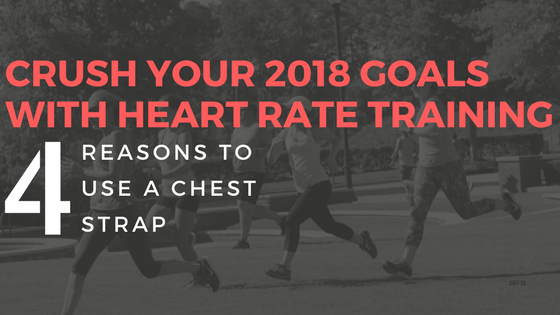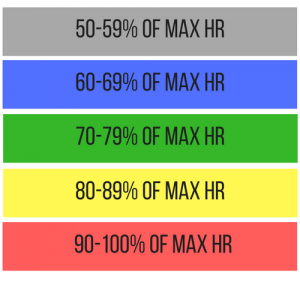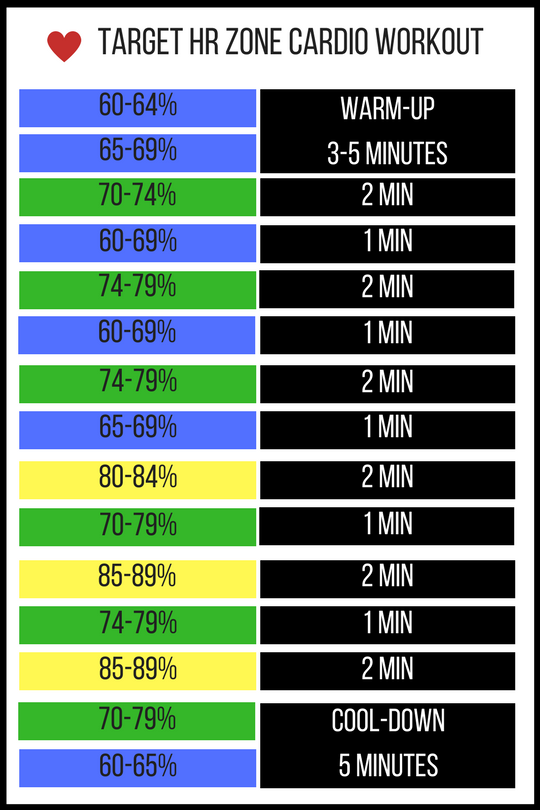It seems like almost everyone is sporting a gadget these days to record their every move, as fitness trackers have become increasingly popular over the last several years. While some devices have the ability to recognize mileage, steps, and even sleep patterns, perhaps the most important feedback when it comes to physical fitness is heart rate. Why focus on your heart rate vs. other biofeedback?
In the past, I was never someone who was super into wearable technology. Quite frankly, working as a fitness professional, I was sure I was getting in enough activity each day and wasn’t too concerned with tracking my effort. It wasn’t until I started doing some research on heart rate training and how we could implement live feedback into our classes/programming at the RFC that I realized just how much of a difference a wearable device, specifically for heart rate, could have on improving my overall fitness.
1.Heart Rate Training translates into better results.
One of the companies I was researching kindly sent me a chest strap monitor to test out with their application, so I started putting it on whenever I’d exercise. I slowly realized just how awesome it was to have live feedback both during and after my workouts. I could see when I wasn’t working quite as hard as I thought and when I was overdoing it. I’d have these “ah-ha” moments when I saw how much of my workout was in the “red zone” (90-100% of my max HR) and quickly understood why I was on the verge of vomiting.
Basically, your heart rate is an OBJECTIVE measurement of your exertion—how hard you are actually working. The higher the intensity, the higher your heart rate will be. Pay closer attention to your effort level to yield better results. Use your current heart rate to know when to push harder, and when to take it down a notch. Simply having a visual of your effort is motivation in and of itself. I personally strive to see specific colors in my HR summary each time I work out.
2.You’ll train more effectively by knowing your zones.
In order to use heart rate training in general, we must first determine what our MAXIMUM heart rate is. Many devices default to the formula 220 - age despite this not being the most accurate estimate, especially for athletes. Other software, such as Garmin and MYZONE, have built in algorithms to set a more accurate max based on your current fitness level. These devices start out using the default, but then track your workouts over time and set your max heart rate based on those trends. This is probably the next best way to determine your max aside from having a treadmill test administered by an exercise physiologist.
From there, heart rate zones usually look something like this:
Although these zones typically correspond with effort, it’s still extremely important to listen to your body. Always use the method of Rating of Perceived Exertion in conjunction with zone training. For example, if working out in the “green zone” FEELS like an exertion of 8 out of 10, it may be best not to push any harder than that. If you ever feel uncomfortable, dizzy, or nauseous, you should stop exercise no matter what the monitor says. Don't forget that your heart is handling your normal day to day functions in addition to your workout, so if you're not feeling a workout from time to time, your body may be dealing with something else (a big meeting, lack of sleep, coming down with an cold, over training, etc.) which is why RPE and listening to your body is so important.
Entering the red zone is not recommended for beginners, and could potentially be harmful for those with health conditions. It should be reserved for the conditioned exerciser or those under the care of a health professional. For general health, stay within 60-85% of your maximum heart rate. Read more about exercising above 85% in Amanda's post: Data Driven Fitness.
Here’s an example of a cardio workout based on target zones:
Choose any cardio machine, body weight exercise, or head outside for a run or walk. Increase the intensity of the exercise to enter following zone, and then decrease intensity to enter the recovery interval. It’s important to note that heart rate may gradually increase and decrease, so don’t expect to immediately enter the next color. Heart rate variability increases with training or improved fitness.
3.You can track your progress more tangibly and accurately.
The more aerobically fit you become, the lower your resting heart rate will be, though it is limited by your genetics. Your heart will also respond differently to more intense workloads as your fitness improves. An individual who is more aerobically fit will have a lower heart rate at the same intensity as someone who is less fit. For example, the level 8 on the elliptical that used to get you into the 70-79% zone may now be keeping you in the 60-69% zone. At the same time, your max heart rate may also increase with training or improved fitness.
Having accurate heart rate readings will give more accurate estimates when it comes to calorie expenditure, especially when the software uses your body metrics (age, weight, height, gender).
4.Chest straps win on accuracy.
When it comes to wrist trackers, I’ve seen plenty of people get way too hung up on their “10,000 steps per day.” While 10,000 steps is excellent goal to have, especially for someone who is otherwise completely sedentary, it can also be pretty irrelevant data if you are looking to improve your VO2, Lactate Threshold, or Power or swimming, cycling, or climbing endurance. Research shows that those who take more steps are healthier than those that take less, however, to further improve your health, improve power, strength, and endurance, it’s important to make time for exercises that increase your heart rate. And, if you're going to be monitoring heart rate, why not do it as accurately as possible?
Most wrist based heart rate monitors detect heart rate using light which means they lose accuracy when you move non-rhythmically, clench your fists, or move your fists (i.e. almost anything other than walking or running). You also lose out on tracking your efforts in a "step counting" sense when your wrist is not moving. For example, during a push-up or a plank, your wrist stays in place and your “steps” won’t count. Chest straps stay in place through most movements and track your heart rate through electrodes, which gives the closest reading to an ECG. Since heart rate correlates with effort, you’ll be sure to get credit for all those burpees, box jumps, lunges, etc.!
Will you try using heart-rate based training to reach your 2018 resolutions and goals?
Did You Know?...
The RFC has chest strap heart rate monitors for sale at the G office for SAS employees and this year we are using this software in some of our classes. When you wear your strap to class, your live feedback will be up on the studio screens to help you get the most out of your workout!
Read more about fitness metrics in Amanda's post: Data Driven Fitness: VO2 Max, Lactate Threshold, Heart Rate, What?




5 Comments
Good blog article! It would be great to see some recommendations for chest straps on the market based on type of activity?
Yes! Finally something about language live.
Nice article. Cardio workout is best to care about our heart. Thank you for sharing. keep posting.
Wonderful article on heart rate training.
Simply amazing for me to know the importance of chest strap in detail.
I loved the way how things have been presented in the table form, very helpful especially for those who are into fitness, Thanks for the article.